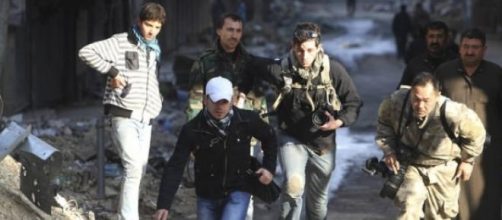For over two years, Syria: Intimate Diaries of the Revolutionhas been chronicling the trialsand tribulations of four young Syrians caught in the country'sthree-year civil war. Two French directors offered cameras to thefour protagonists to film the upheavals in their everyday lives. Theythen edited over 100 short films that make up this grippingwebdocumentary. On December 20 at 6:30pm, the French-Germantelevision station Arte broadcasts a behind-the-scene documentary ofthis unique media experience.
“Terrorismin Syria resembles a snake,” explains Oussama with feeling.
“Thetail is Al Qaïda al Nousra, the head is (Bashar) al-Assad.” Thestatement by the former pharmacist is directed with venom at the tinylens of an iphone 5 he is holding at arms length. Like so many dailyfilms he has made before, this monologue in the intimacy of Oussama'sroom then finds its way to the editing suite of co-directors CarolineDonati and Carine Lefebvre-Quennell in Paris. Within days, the twoveterans of Middle East politics process it for two major websites,Arte and the French online media company Médiapart. In this way,Donati and Lefebvre-Quennell have devoted over two years to bringingout grassroot testimony of daily life in Syria, as seen through theeyes of Oussama, Majid, Joudi and Amer.
“Whenwe first started in November 2012, we never imagined this wouldbecome such an odyssey,” explains Donati, somewhat ruefully as shesmokes nervously outside a Paris cinema showing extracts of her work.But she has no regrets about the engagement she has made to tellingthe story from beneath the Syrian rubble.
“Thisis not the war we see in the news,” she insists, “this is realityin the sidelines, the lulls, the wild enthusiasm, the worry, thesolitude, and also the philosophy these young people carry.”
Inthe course of these dozens of short films it is often the solitudethat comes through strongest. The cameras have become intimistmirrors, verbal diaries that the protagonists seem to hang on to intheir darkest moments.
Amer and Majid testify as they dodge bombs andbullets. They are desperately attempting to survive and hang ontodreams that fuelled their involvement in the non-violent revolutionthey helped to instigate in Damascus and Aleppo, respectively.Oussama films himself in a forced exile devoted to unremittingcampaigns to support those he left behind. Whilst his sister Jouditestifies to the horrors of Assad's prisons: after seven months ofinterrogations and torture, she describes with emotion her struggleto survive, sitting in the unsure security of a Lebanese refugeecamp.
Thesevisual diaries evolve chronologically in front of our eyes. Themonologues with the camera make for riveting, if at timesunbearable, watching.
“Strangely, in our isolation, we've become adistant family,” explains Oussama in a telephone interview fromTurkey with Blasting News. “I didn't really know Amer and Majidbefore. But when the latter was injured recently whilst following abrigade from the Free Syrian Army, I felt torn apart, it was like myown brother had been wounded.”
Oussamawas initially a reluctant participant in the media adventure. “Itwas really tough at first, it just didn't feel natural. I mean, whywould anyone be interested in my experience?”, he wonders out loud.Then, the conviction steps in: “This revolution has gone throughseveral stages, peaceful, armed, locally-organised, terrorism, it'sSO complicated. But we simplify the equation.
We see how ourtestimonies are a reaffirmation of our initial dreams andaspirations. While the media paints black-and-white pictures of Syriaour little films are different shades of grey.”
Thefilms have become all the more vital as Syria has become moreinaccessible to journalists. In their press freedom index for 2013and 2014, Reporters Without Borders claims Syria is the world'sdeadliest nation for journalists. “The role of these citizenjournalists is vital,” explains Salam Kawakibini, a politicalscientist close to the Syrian opposition. “Since reporters cannotventure into Syria anymore, these four civilians provide us vitalinsight into the daily suffering of the population caught in thisinferno.
And it reflects the vitality of this generation thatcontinues to innovate and resist creatively in the face of abarbarity that is unimaginable.”
Thewebdocumentary is updated every fortnight and has just beenguaranteed funding for a further year by Arte TV. It has reapedseveral prestigious international awards and is visited by hundredsof thousands of internet users worldwide.

